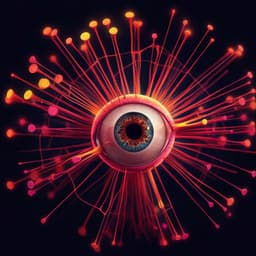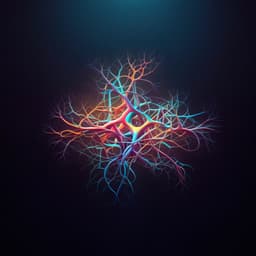
Engineering and Technology
Neural network-based Bluetooth synchronization of multiple wearable devices
K. K. Balasubramanian, A. Merello, et al.
This exciting research by Karthikeyan Kalyanasundaram Balasubramanian and colleagues introduces a groundbreaking application-level solution for synchronizing Bluetooth-enabled wearable devices. Utilizing a neural network, the team compensates for timing variations in high-frequency motion capture, paving the way for advancements in wireless communications beyond Bluetooth.
~3 min • Beginner • English
Introduction
The study addresses the challenge of accurately synchronizing multiple Bluetooth Low Energy (BLE) wearable devices for group, multi-limb, and multi-agent measurements, where existing BLE methods fall short of mutual synchronization accuracy. BLE advertisement mode poses security concerns, while connected (GATT) mode provides encryption and flexibility but inherits non-deterministic transmission timing. Real-time operating systems (RTOS) on wearables rely on precise hardware clocks; modifying low-level timing (as in typical clock synchronization protocols like FTSP, RBS, TPSN) can disrupt multitasking and scheduling, leading to failures. Additional non-idealities—temperature, power, process/aging variations, crystal drift, BLE anchor points and retries—introduce propagation delays and non-deterministic latency, producing time shifts between devices. The research purpose is to develop an application-level, hardware-agnostic synchronization method that preserves RTOS stability and BLE security while achieving sub-millisecond mutual synchronization across multiple wearables.
Literature Review
Prior work on wireless and BLE synchronization includes clock synchronization protocols for sensor networks (FTSP, RBS, TPSN), which leverage timestamping and remedies like pre-experiment clock tuning, runtime tick adjustment, or applying time delays. These methods can offer high accuracy but typically require tuning low-level hardware timing, which is problematic for RTOS-based wearables due to timer-critical routines, event synchronization, and scheduling constraints. BLE-specific studies highlight the impact of connection intervals (minimum 7.5 ms) and retransmissions on latency and jitter, limiting synchronous applications and practical sampling rates. Alternative proprietary protocols (ANT+, WiFi, Zigbee) may alleviate channel issues but at the cost of higher power, size, and requiring non-standard receivers. Consequently, a universal, GATT-based, application-layer approach that avoids direct hardware clock manipulation is needed.
Methodology
Hardware and software: The team used Kinematics Detectors (KiD), high-performance wearable IMU devices supporting BLE 4.2 with reconfigurable firmware and onboard storage. A custom graphical User Interface (UI) on a host computer manages devices via GATT using START, STOP, and MARK commands for acquisition control, maintenance (memory erase, renaming), and online labeling. Wearables are worn on limbs or stacked vertically on a fixed plane to share spatial motion for synchronization evaluation. KiDs capture motion at ~200 Hz and store data until STOP; labels are appended in-device.
Synchronization concept: Instead of altering device clocks, the method inserts a neural network (NN) layer at the application level operating as a virtual clock. Time-stamped bidirectional communications between host and devices provide training data. BLE events generate timestamps at both host and device sides for transmissions and acknowledgments. The system models the relationship between master and slave times considering device offset, frequency drift, and BLE-induced non-deterministic jitter. A three-layer perceptron (20 hidden neurons) is trained (Python, RMSE loss) on timestamp series to predict and compensate delays, effectively computing per-device timing corrections T1, T2, T3 for message scheduling. The NN outputs a virtual clock v(t) to align device actions without modifying hardware clocks.
Experimental procedure: Motion capture experiments included (1) pre-experiment setup—charge devices, clear storage, link to UI, auto-train NN per device within up to 50 m range; (2) acquisition—START initiates and STOP ends recording; MARK inserts labeled events (16-bit unsigned labels 0–32767) during capture; (3) post-analysis—download data via USB for processing/classification. For synchronization assessment, multiple KiDs were vertically stacked to ensure identical spatial signals; periodic MARKs were sent while recording, and corresponding timestamps on host and devices were logged. Frequency drift was evaluated by periodically reading device and system times (e.g., every 60 s) over long sessions at 20–25 °C. Bluetooth latency was measured by sampling round-trip times between host and devices under multi-device connections. Equations relating master/slave clocks and non-idealities were used to frame the estimation problem; NN-based virtual clock compensates for offset and jitter so that synchronization error remains below the sampling interval. Cross-platform validation was conducted on PC/Windows, Linux, and Mac. Battery drain during synchronized capture was measured to verify power impact.
Key Findings
- Without synchronization, multi-device BLE operation exhibits non-deterministic temporal shifts, with an average synchronization error of about 30 ms. Frequency drift among devices was observed: KiD1 = 199.68 Hz, KiD2 = 199.72 Hz, KiD3 = 199.82 Hz (vs. nominal 200 Hz). Bluetooth latency per device under multi-device conditions was non-deterministic: KiD1 = 9.5 ± 1.762 ms, KiD2 = 23.8 ± 2.01 ms, KiD3 = 32.5 ± 2.37 ms.
- Device sampling frequency stability for a single KiD over 100 repeated 25 s trials: 199.846 ± 0.1430 Hz with R = 0.9987.
- The NN virtual clock effectively learned the time relationship between host and devices, achieving correlation R = 0.9967 between predicted and actual times after 100 iterations.
- Synchronization accuracy improved markedly with the NN layer. The figure caption reports improved average synchronization error to 1.25 ms (Fig. 4e), while the main text reports an average synchronization error across devices of 0.356 ms with low delay variation during synchronized events (e.g., between MARK 337 and MARK 338).
- Cross-platform trials with 2–4 devices over 150–200 iterations achieved a 97.3% synchronization success rate; failures (2.7%) were attributed to OS library updates affecting timing and to intentional tests of complete battery exhaustion.
- Battery life during synchronized operation met design goals: approximately 150 minutes of continuous acquisition without significant impact from added synchronization traffic.
- The labeling mechanism enabled precise online artifact extraction for tasks (e.g., TASK 134 of 7 s corresponding to ~1400 samples at 200 Hz), scalable across multiple synchronized devices.
Discussion
The findings demonstrate that an application-level neural network acting as a virtual clock can overcome BLE’s intrinsic non-deterministic delays and device frequency drift to achieve mutual synchronization across multiple wearables without altering hardware clocks or RTOS timing. This addresses the core challenge that CSP-style low-level clock tuning is unsafe in RTOS-based systems and that BLE connection intervals and retransmissions introduce unpredictable latency. By learning the end-to-end timing behavior from timestamps and compensating transmission times, the NN layer reduces synchronization error well below the sampling interval, enabling reliable, synchronous multi-limb and multi-agent data capture at 200 Hz with secure GATT communication. The approach is scalable (validated on 2–4 devices) and portable across OS platforms, with minor failures traced to software library and battery conditions. The synchronized labeling further facilitates downstream analytics by embedding task markers directly into device memories, simplifying segmentation and interpretation of high-frequency data. Overall, this expands the feasibility of synchronized BLE-based behavioral and neuroscience experiments outside specialized labs.
Conclusion
This work introduces a universal, application-level synchronization solution for BLE wearables that embeds a neural network virtual clock to predict and compensate time shifts arising from device non-idealities, OS scheduling, and BLE jitter. It achieves sub-millisecond to millisecond-level mutual synchronization across multiple KiDs at 200 Hz, maintains data security via GATT, and adds a robust online labeling mechanism for artifact extraction. The method avoids risky hardware clock manipulation under RTOS and demonstrated scalability and cross-platform portability without compromising battery life. Future directions include extending the approach to heterogeneous Bluetooth sensor nodes for improved sensor fusion (e.g., EEG, ECG), refining robustness against OS/library changes, and exploring higher device counts and more challenging wireless conditions to further characterize performance limits.
Limitations
- BLE protocol constraints such as minimum 7.5 ms connection interval and packet retransmissions introduce inherent, non-deterministic latency and jitter that must be continuously compensated; they also limit practical synchronous operation rates in many devices.
- Synchronization failures (2.7% in trials) occurred due to OS library updates impacting timing in the UI and deliberate battery exhaustion; synchronization depends on stable software stacks and adequate device power.
- The NN approach requires additional timestamp exchanges and training per device/session, adding communication overhead (though battery life remained around 150 minutes in tests).
- OS scheduling on general-purpose computers can introduce additional variability that needs to be handled by the application-layer predictor.
- Frequency drift and environmental factors (temperature, aging) persist at the hardware level; while compensated in software, extreme conditions could challenge model generalization.
Related Publications
Explore these studies to deepen your understanding of the subject.







